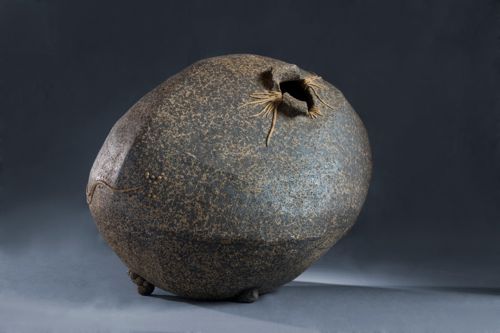This weekend I will be back with friends and colleagues at the University of Michigan Museum of Art (UMMA) to facilitate a teacher workshop about working with Art21 education materials and teaching with El Anatsui’s gorgeous exhibition, When I Last Wrote To You About Africa. This being Art21’s second visit to UMMA, I am looking forward to once again working with Pam Reister, Jann Wesolek, and all of the participants joining us this weekend.
El Anastui, one of my favorite artists from Season 6, is in some ways an educator’s dream. His sculptures and installations reference history, culture and memory while simultaneously exploring the possibilities of found materials and different processes for making art. And while Anatsui is best known for his stunning, draped metal sculptures, there is more to the work with than meets the eye… and that’s quite a bit to begin with.
For example, if we step back four decades ago to Anatsui’s initial work in Ghana, the artist began using materials from his immediate surroundings—carving into wooden trays much like those sold in markets to display fruit and vegetables—and then creating works with adinkra-like symbols prominently featured. As Olu Oguibe describes in the magnificent catalogue that accompanies the show, Anastui has been guided by the following principles since this early work:
- Pay close attention to location and environment
- Learn whatever you can from local practitioners
- Use found objects and materials from your surroundings, especially your immediate surroundings
- Let the medium and materials suggest, even dictate, the form
- Acknowledge the potential for art to serve as a metaphor or visual allegory
Anatsui’s ceramic sculpture from 1978, Omen, explores how brokenness can somehow inspire new life and healing. From the small burst of an opening to the coating of manganese that speckles the surface formed from damaged ceramic pieces, Anatsui’s work can represent ideas about fragility and even political instability in Africa.
What I enjoy about Anatsui, especially up until this point in his work, is that he bridges a gap that lives between art and craft. He challenges the viewer to rethink craft as fine art because these kinds of works are more than simply being about process and form, even though the work relies on it.
If we fast-forward to Anatsui’s metal sculptures of the past decade we find him staying true to the aesthetic principles described in Oguibe’s essay. Utilizing the bottle caps from discarded liquor bottles Anatsui continues to create flexible, malleable works that almost fool the viewer into believing they are tapestries. The artist goes one step further with these works and allows curators and collectors to install the works as they see fit, which in some cases might lead to different interpretations of the work. The same work installed in a white cube vs. being installed on the façade of a building can inspire disparate ideas and conclusions, no doubt.
For these reasons and more, teaching about and with Anatsui’s art, I think, requires a slow digestion of what sets him apart. Maybe it’s through lingering with the work or perhaps reading about it beforehand, but context in the case of Anatsui can play a huge role in understanding, not to mention enjoyment. I also think being careful not to lump Anastui’s sculpture with “recycled art” is important, too. Talking with students about the difference between repurposing and recycling can lead to a more meaningful experience with the work. Anatsui doesn’t make bracelets out of bottle caps, he is creating unique sculpture with a bit more of a story.
Students are able to not only enjoy multi-layered entry points into Anatsui’s works, but they also have the opportunity to re-see some of the most common elements in their own lives through engagement with them. Challenging students to perhaps “see as Anatsui sees” can become the beginning of confronting a world often discarded. When I see Anatsui’s work and engage with it, I often ask myself how I can get students to reconsider what’s readily available in order to make something more than “cute”.
Finally, I think teaching with Anatsui allows for a real synthesis between working with traditional principles of design and postmodern principles such as layering. It’s an opportunity for students to begin with technique, storytelling, or both, and an opportunity to perhaps create something monumental.






Pingback: Matt Forte Teaching with El Anatsui | Art21 Blog | Matt Forte
Pingback: Teaching with El Anatsui | Art21 Blog | limokeroti
Pingback: Revamping Art Education for the Twenty-First Century | ART21 Magazine